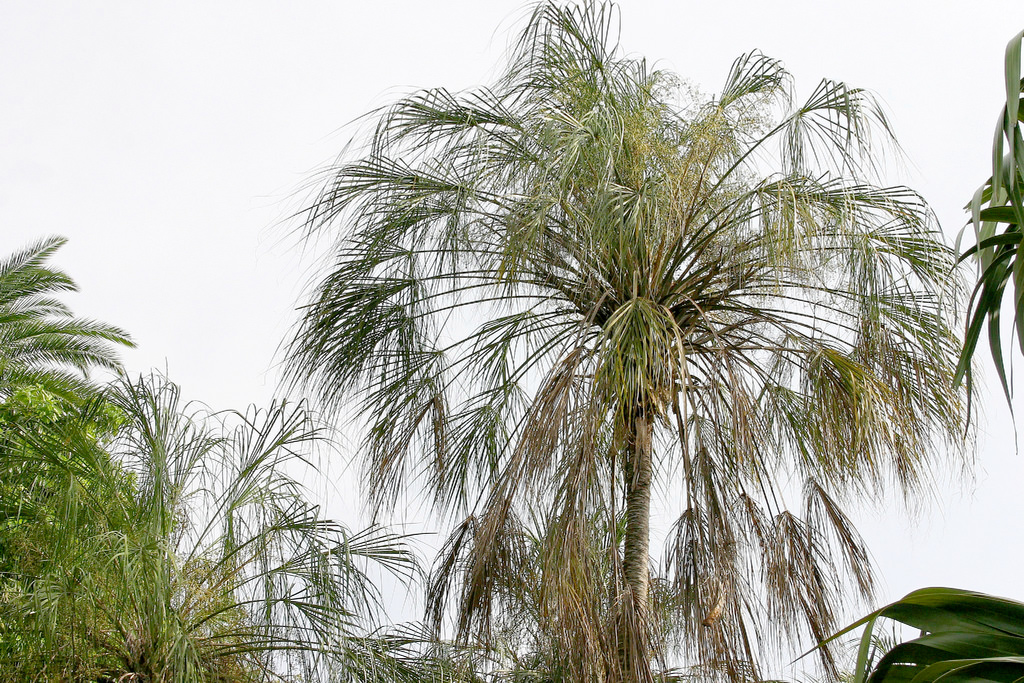Cape river fan palm
(Livistona lorophylla)

Description
Functionally dioecious palm. Trunk to 15 m tall, 8-20 cm in diameter; breast high, leaf scars raised, internodes narrow, grey, persistent petiole stubs in the lower portion only. Leaves 25-40 in a globose crown; petiole arching, 70-200 cm long, 10-17 mm wide, adaxially flat, margins with scattered single curved black spines up to ca 10 mm long; leaf-base fibres moderately prominent, coarse, persistent; lamina costapalmate, regularly segmented, circular, 60-100 cm long, coriaceous, glossy mid green to pruinose grey on both surfaces; lamina divided for 85-98% of its length, with 34-50 segments, depth of apical cleft 55-78% of the segment length, apical lobes acuminate to filiform, semi-pendulous; parallel veins 8-10 each side of midrib; transverse veins thinner than parallel veins. Inflorescence unbranched at the base, not sexually dimorphic, 20-160 cm long, not extending beyond the limit of the crown, branched to 3 orders; partial inflorescences 4-8; prophyll not seen; peduncular bract 1; rachis bracts loosely tubular, sparsely tomentose; rachillae 1-6 cm long, glabrous. Flowers solitary or in clusters of 2-4, broadly funnel-shaped, 1.2-3 mm long, cream; sepals triangular, 0.7-1.8 mm long, membranous, acute; petals triangular to broadly ovate, 1.2-3 mm long, acute to cuspidate, cream; stamens about 1.6 mm long. Fruit obovoid to pyriform, 8-14 mm long, 6-9 mm in diam., pruinose dull black; epicarp with scattered lenticellular pores; mesocarp thin, fibrous; endocarp thin, crustaceous. Seed ellipsoid, 7-9 mm long. Eophyll not seen. (Dowe, J.L.)/Palmweb. Editing by edric.Livistona lorophylla was described by Beccari (1921) based on Johnston s.n. collected at Cambridge Gulf, Western Australia, and named for the resemblance of the leaf segments to leather straps. Livistona kimberleyana was described by Rodd (1998) based on Rodd 2866 collected from Mt King, Western Australia. This taxon was distinguished from L. lorophylla primarily by grey pruinose rather than green leaves. However, in some populations individuals exhibit intermediate leaf colour. As noted by Rodd: ?? It is possible even that further study may show it to represent an arid race of L. lorophylla, but for the meantime it seems preferable to treat it as a distinct species.? Other than leaf colour, there are no other characters to distinguish the taxa and L. kimberleyana is therefore placed as a synonym of L. lorophylla. The original spelling provided by Beccari (1921) was L. loriphylla. This was corrected to L. lorophylla by Rodd (1998). Some populations now regarded as L. lorophylla had previously been assigned to other taxa. Fitzgerald (1918) misidentified it as L. alfredii, occurring in the King Leopold and Durack Ranges (= Rodd?s L. kimberleyana), hile Gardner (1923) noted it at the same locations, also under L. alfredii, as well as throughout the presently known distribution of L. lorophylla throughout the Kimberleys. Gardner (1930) also referred to L. lorophylla as L. inermis in a later systematic account. Conversely, some populations of L. inermis in the Northern Territory have been incorrectly named as L. lorophylla (Chippendale, 1972). Livistona lorophylla is a moderate sub-canopy to canopy palm to 15 m tall; leaves are small and regularly segmented; segment apices are semi-pendulous, and with a bifurcate cleft to 78% of the segment length; petiole margins are strongly spined in the basal portion; the inflorescence is unbranched, not extending beyond the limit of the crown, and with up to 8 partial inflorescences; bracts are loosely tubular; flowers are cream; fruit are obovoid to pyriform, to 14 mm long to 9 mm wide, and pruinose dull black at maturity. (Dowe, J.L.)/Palmweb.
Taxonomic tree:







